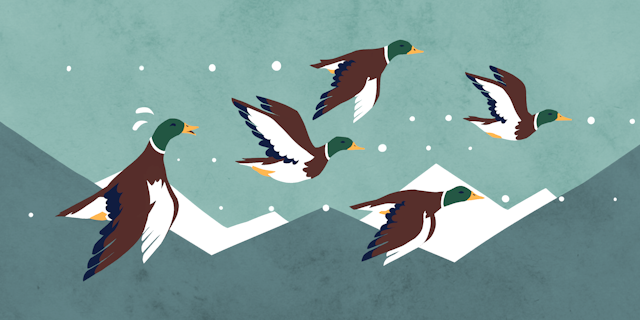This is an article from Curious Kids, a series for children. The Conversation is asking kids to send in questions they’d like an expert to answer. All questions are welcome – serious, weird or wacky!
Why aren’t birds pulled down by the force of gravity while they’re flying? – Claudia, age 7, Canberra.
This is a great question, and funnily enough there is a recent news story out which helps answer it.
In the United States, a dead goose weighing over 5kg fell from the sky. This poor goose shows us that flying birds can fall from the sky under the force of gravity, just like everything with mass.
The larger the mass (or how much something weighs), the larger the force of gravity. This goose fell from the sky because it was killed while flying. The other geese flying with it did not fall because they were doing a few important things to fight the effects of gravity.
To stay up, the bird must overcome gravity with a force called “lift”. Lift is a very active force, made by moving the wing at speed through air. It causes the bird to rise upwards, as shown in the picture below.

To create lift, the bird holds the front part of its wing slightly higher than the back part. As the air passes over the wing, (from front to back), the air underneath is pushed downwards. This pushes the wing (and bird) upwards. A bird’s wings are just the right shape to build this upward force.
Birds of different shapes and sizes have wings that provide the perfect amount of lift for their needs. The Australian pelican is one of the largest flying birds, weighing almost 7kg - that’s about as much as two bricks! A pelican’s wings need to be very big to create enough lift to overcome gravity. They also need to move very fast for take off. That’s why large birds like pelicans typically have to run a long way before flying.
Here’s a video showing how difficult take off can be for a pelican.
Large flying birds can also create lift using patches of warm air that form, for example, over hot rocky ground. Hot air rises and that means birds can spread their wings over these patches and get a free lift.
Read more: Curious Kids: Why don’t cats wear shoes?
Smaller birds also need to create enough lift to be able to fly. That’s why so many birds are light compared to animals of similar sizes. For example, a fully grown zebra finch bird is about the same size as a house mouse but weighs just 12g, while the mouse weighs around 19g.
Birds also have hollow bones with lots of air spaces inside them. If you break open a chicken bone the next time you have chicken for dinner, you will see this for yourself.
Hello, curious kids! Have you got a question you’d like an expert to answer? Ask an adult to send your question to us. You can:
* Email your question to curiouskids@theconversation.edu.au
* Tell us on Twitter by tagging @ConversationEDU with the hashtag #curiouskids, or
* Tell us on Facebook

Please tell us your name, age and which city you live in. You can send an audio recording of your question too, if you want. Send as many questions as you like! We won’t be able to answer every question but we will do our best.

